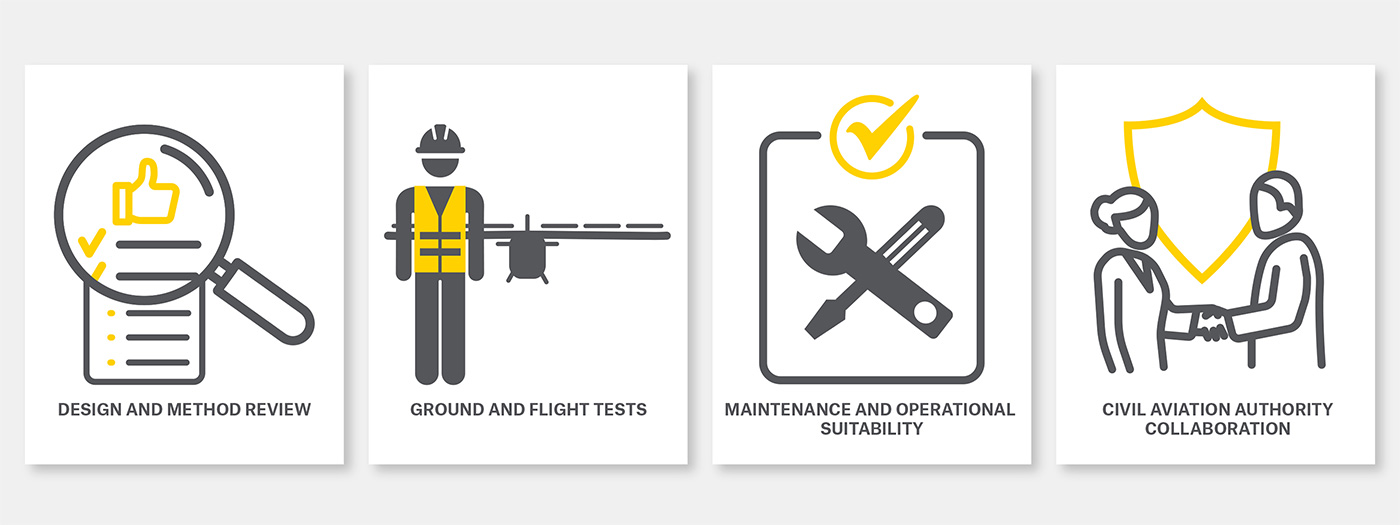Wisk leverages strategic partnership, tapping Boeing CTO, Chief Engineers, and Technical Fellows for impartial and in-depth analysis
Designing and certifying a new aircraft is unquestionably a complex, time-consuming, and capital-intensive process. For aircraft that conform to existing regulations (for example airplanes, rotorcraft, gliders, etc.), the type certification process can take between 5-9 years — not including all of the effort leading up to the start of the official certification process.
However, one of the unique advantages of having Boeing as both an investor and a strategic partner is the ability to lean into Boeing’s expertise and experience in aerospace product development and certification. Through a Non-Advocate Review process, we are able to accelerate our development while reducing risk and streamlining the certification process.
The Certification Process
While different jurisdictions and civil aviation authorities have different processes for aircraft certification, for the purposes of this article, we’re going to focus on the FAA’s certification process, which includes several key components:
- A review of any proposed designs and the methods that will be used to show that these designs and the overall airplane complies with FAA regulations;
- Ground tests and flight tests to demonstrate that the airplane operates safely;
- An evaluation of the airplane’s required maintenance and operational suitability for the introduction of the airplane into service; and
- Collaboration with other civil aviation authorities on their approval of the aircraft for import.

Components of the FAA Certification Process
Arguably, one of the more challenging components above is the first item – a review of proposed designs and methods of compliance with FAA regulations. This element requires significant work prior to beginning the certification process, as well as throughout the certification process.
However, proper planning, prior certification experience, and regular reviews can streamline and ensure that this phase of the certification process is smooth, with as few surprises as possible.
Leveraging Strategic Resources
At Wisk, one of our strengths is our relationship with Boeing – which is both an investor and a strategic partner. Through this relationship, we are uniquely positioned to leverage the power of Boeing by tapping into their wealth of knowledge, experience, and expertise – including certification expertise – to accelerate our development and reduce program risk.
One of the many ways we do this is through what’s called a Non-Advocate Review, or NAR, which provides an opportunity for transparent and constructive discussions around our Generation 6 program.
Non-Advocate Review (NAR)
The Non-Advocate Review is a well-known concept within the aviation industry and allows companies to identify areas for improvement, as well as make recommendations based on diverse corporate knowledge. NAR programs can be conducted at any phase within a development program to deep-dive issues or review program development.
In a recent Non-Advocate Review, we invited several senior leaders from across Boeing – including Boeing and Aurora Flight Science’s Chief Technical Officers as well as a number of Vice Presidents, Technical Fellows, and Chief Engineers. Each participant brought unique expertise to the review, representing a variety of relevant disciplines – from software to product development to aircraft configuration, and more. However, the majority of participants were not directly involved in the development of the Generation 6 aircraft or the ongoing Generation 6 program. Hence, the “non-advocate” review.
The discussions were candid and transparent, and allowed the non-advocates to challenge our thinking in a positive and constructive way. Specifically, the process identified and recorded 71 actions across multiple areas, including system requirements V&V, simulation & test activities, ecosystem & airspace integration activities, and autonomy certification.
Sebastien Vigneron, Wisk’s Sr. Vice President of Engineering and Programs, said,
“For Wisk, hosting Non-Advocate Reviews is important because we want an outside, unbiased perspective on the work that we’re doing. This process allows us to minimize risk and advance our development by tapping into a resource that few others in the industry have access to. The NAR process allows us to challenge our ideas and get feedback and recommendations in a very transparent way.”
Transparency and Continuing Momentum
Our most recent NAR process was a challenging environment – but that’s the purpose. It’s meant to be that way. We want to be challenged to not only a better, more robust program, but also to ensure that we are delivering the best product.
While the environment generated good dialogue and a number of outcomes for our team, we were very pleased to hear a number of the NAR participants point out that our progress in many areas was much further along than they would have expected at this stage of the program.
Bringing a new aircraft to market is exceptionally complex and requires the right resources and team to be successful. Further, employing the right processes to maximize the value of these resources is critical. We are incredibly fortunate to have access to Boeing and we believe our NAR process is one of the ways in which we can ensure that we’re maximizing the value of that resource, while simultaneously advancing our mission to make safe, everyday, autonomous flight a reality.